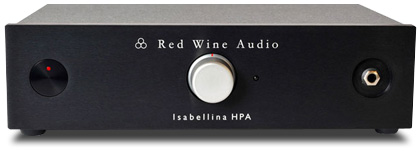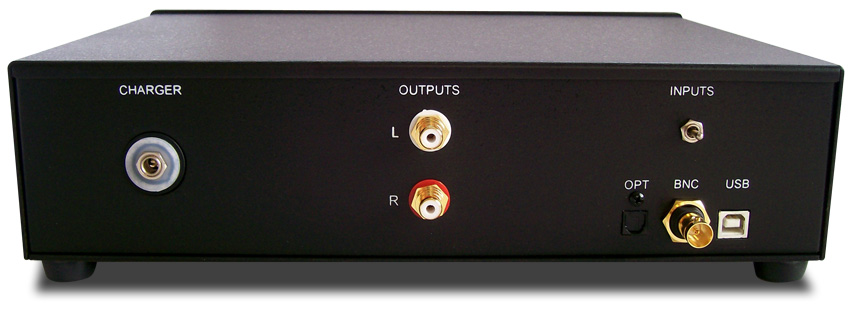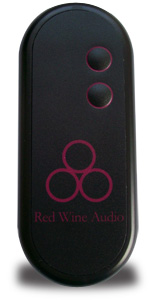 April 2010
Red Wine Audio Isabellina HPA
Headphone Amplifier-DAC

| Associated Equipment Speakers -- Wilson Audio Specialties Sophia,
Audioengine A2
Integrated amplifier -- Jeff Rowland Design
Group Concentra
Digital sources -- Wadia 830 CD player,
Logitech Transporter, Apple MacBook, Devilsound DAC
Interconnects -- Cardas Audio Neutral
Reference
Speaker cables -- Cardas Audio Neutral
Reference
Headphone system -- Sennheiser HD 600, AKG K
701, Ultimate Ears UE 11 Pro, Ray Samuels Audio Emmeline The Predator
Accessories -- Audio Power Industries Power
Pack II, Cardas Audio Signature XLR, RCA and BNC caps |
|
|
|
 Getting off the
AC grid is one of the holy grails of high-end audio. Gone are worries of power surges,
spikes, and brownouts ruining your prized system. Plus, with the increase over the last
decade in the number of consumer-electronics components in the average home, by separating
one’s system from the rest of the house’s electrical current, there’s no
chance of cross-pollution from dirty household electronics obscuring a recording’s
finer details. One of my greatest regrets, audio-wise, is not having sprung for the sealed
lead-acid battery power supply from Jeff Rowland Design Group when I bought my Concentra
integrated amplifier ten years ago. It’s no longer available, and my efforts to find
a used one have so far been fruitless. There are plenty of power-conditioning products
available, but these still must connect to the house’s AC and the surrounding power
grid, which requires plenty of filtration. Getting off the
AC grid is one of the holy grails of high-end audio. Gone are worries of power surges,
spikes, and brownouts ruining your prized system. Plus, with the increase over the last
decade in the number of consumer-electronics components in the average home, by separating
one’s system from the rest of the house’s electrical current, there’s no
chance of cross-pollution from dirty household electronics obscuring a recording’s
finer details. One of my greatest regrets, audio-wise, is not having sprung for the sealed
lead-acid battery power supply from Jeff Rowland Design Group when I bought my Concentra
integrated amplifier ten years ago. It’s no longer available, and my efforts to find
a used one have so far been fruitless. There are plenty of power-conditioning products
available, but these still must connect to the house’s AC and the surrounding power
grid, which requires plenty of filtration.
Vinnie Rossi, of Red Wine Audio, in central Connecticut,
understands this. Since 2005 he’s been producing components powered by sealed lead
acid (SLA) batteries. Available direct from the factory and sold with a 30-day money-back
guarantee, RWA’s product line includes the Signature 30.2 stereo amplifier, Signature
70.2 monoblock amplifiers, Isabella tube preamplifier, Isabellina DAC with USB input, the
iMod modification for the Apple iPod, plus speaker cables and interconnects. Now, add to
that list the new Isabellina HPA headphone amplifier and DAC with USB input ($2500 USD).
Unique by design
The Isabellina HPA combines the Isabellina DAC with the
headphone amp that’s available as an option with the Isabella tube preamp. In
addition to high-current SLA battery power with dedicated linear voltage regulators for
both the analog and digital sections, the Isabellina HPA also features the Smart 1224
board, which monitors the battery voltage and automatically switches the unit off if the
voltage falls too low. This board also features 0.5-second inrush current limiting, to
prolong the life of the internal components.
The philosophy behind the DAC is a bit unusual in that a
modern DAC chipset is not used. Rossi believes that even modern DAC chipsets boasting
impressive specs sound cold, sterile, and analytical. His answer is to use a new-old-stock
(NOS), 16-bit, non-oversampling, non-upsampling DAC chip with no digital filtering, which
he claims offers a more natural sound, for a more emotionally involving musical
experience. The analog output stage is a discrete class-A output with no op-amps.
Looks-wise, the Isabellina HPA is handsome in minimalist
fashion, and mirrors the appearance of its sibling products. The casework is powder-coated
aluminum with a nice nubby finish, and the faceplate is black-anodized aluminum. The front
panel has a centrally located volume-control knob of silver-painted aluminum, flanked on
the right by a 0.25" stereo headphone output jack, and on the left by a
flush-mounted, soft-touch power button. On the power button is a red LED that blinks
slowly when the battery voltage gets low.
On the center of the rear panel is a pair of vertically
arrayed RCA line-output jacks. To their left is the jack for the battery charger, and to
their right is a three-way toggle for selecting the digital input: optical (TosLink),
coaxial, or USB. The USB input accepts sample-rate frequencies up to 48kHz, while the
coaxial and optical inputs accept up to 192kHz.
The Isabellina HPA comes with a dedicated wall-wart charger
and a handheld remote control. An optional 12VDC output ($100) is available for powering a
Wadia 170iTransport.
At 12"W x 3.5"H x 9"D and weighing ten
pounds, the Isabellina HPA isn’t really "portable," but it’s small and
light enough to haul around in a padded duffle. My local coffeehouse and bakery has free
WiFi, and I was tempted to take it there for some remote listening, but was too concerned
about spilling coffee on something that didn’t belong to me to tempt fate. However, I
was able to use it all over my house, and even ended up taking it to work.

Setup
In addition to my Sennheiser HD 600 headphones, I listened
to the Isabellina HPA with a pair of AKG K 701 headphones that Vinnie Rossi had sent
along. The Sennheisers are analogous in sound to my Wilson Audio Sophia loudspeakers: very
neutral, with tightfisted bass, delicate and detailed treble, and a very smooth midrange.
The AKGs, on the other hand, sound very lush -- comparable to what I’ve heard from
the B&W Nautilus 800 -- with gorgeous tone, but a little softer all around,
particularly in the bass. However, because I was unfamiliar with the AKGs and preferred
the sound of my Sennheisers, I did almost all my listening with the latter. In addition to
listening at home with headphones, I used the Isabellina HPA as a preamp and DAC to drive
a pair of Audioengine A2 powered desktop speakers, which I use for listening at work. For
all listening, I used my Apple MacBook laptop as a source, with Apple Lossless music files
in iTunes streamed through the MacBook’s USB output.
The sound of music and the sounds of silence
The first thing I noticed about the Isabellina HPA was that
it produced zero noise. There was a complete absence of hiss, which I assume was
directly attributable to the use of battery power. Music emerged with no overlay of sonic
artifacts, grunge, or edge. All aspects of the music benefited from this lack of noise,
but where I appreciated it most was in the quiet, slow passages of jazz ballads. On Miles
Davis’s "Blue in Green," from Russell Gunn’s Russell Gunn Plays
Miles (CD, HighNote HCD 7161), both Gunn’s trumpet and Orrin Evans’ piano
floated in a deep black space, with plenty of air and space between the notes. Also
commendable was the performance of the DAC. The overall sound was very smooth and
analog-like, with no grain or glare. Fine details, such as the piano’s woody
resonance and Gunn’s vibrato, were realistically conveyed -- the sound had the
natural warmth that I hear at a live performance. Cymbals and chimes had a bright, ringing
quality, with sustained reverberation and decay.
The HD 600s have true full-range bass that extends down to
20Hz, and the Isabellina HPA drove them easily, solidly controlling the drivers to extract
from recordings every last bit of low-frequency energy. As a result, I mined my music
collection to listen to a lot of bass-centric music. In "Technicolor Nightmare,"
the opening track of Christian McBride’s three-disc Live at Tonic (CD,
Ropeadope 62072), McBride’s electric bass not only plumbs the depths of the lower
octaves, but also is positively percussive, every note not only heard but felt --
the Isabellina HPA conveyed every little inflection, pluck, and slap of his bass. Even in
the face of this sonic assault, the Red Wine was able to deliver the current with no
audible distortion.
Despite the brute force that the Isabellina HPA could bring
to the table, it was also capable of being light on its feet when required. With more
delicate music, such as the acoustic guitar in the title track of Ry Cooder and V.M.
Bhatt’s A Meeting by the River (CD, Water Lily Acoustics WLA-CS-29-CD), the
string tone had the requisite bite and metallic sound, without any harshness. The midbass
and midrange were tonally warm, but free from any colorations that would sound unnatural.
 One of the Isabellina
HPA’s greatest strengths was that it let me enjoy the music and forget that I was
using headphones. But despite its primary purpose as a headphone amp, I got one of my
biggest kicks from the Red Wine when I used it as a preamp-DAC to drive the Audioengine A2
powered speakers that I use at work. While not quite capable of room-filling sound, the
A2s are excellent speakers for nearfield desktop listening, producing a smooth treble and
midrange, ample bass that belies their small size, solid images, and a soundstage
that’s fairly realistic in width and depth. With the Isabellina HPA, the sound
emerging from the A2s was solid and tightly focused, with additional weight, especially in
the bass. The A2s sound a little warmer than my HD 600s, but except for the very lowest
bass frequencies, which were more truncated with the A2s, my comments with regard to the
sound quality of the HPA through both apply equally. Additionally, the soundstage was very
deep, extending way behind the screen of my laptop. Controlling the Red Wine’s volume
level with either the front-panel volume knob or the remote was also more convenient than
reaching around to the rear of the left A2. You might question the value of driving a $200
pair of desktop speakers with a $2500 preamp-DAC, but consider this: If you’re in the
market for a headphone amp in this price range and, like me, can’t use headphones at
work, this quality of sound and level of versatility are big selling points. You
won’t feel like settling for less. One of the Isabellina
HPA’s greatest strengths was that it let me enjoy the music and forget that I was
using headphones. But despite its primary purpose as a headphone amp, I got one of my
biggest kicks from the Red Wine when I used it as a preamp-DAC to drive the Audioengine A2
powered speakers that I use at work. While not quite capable of room-filling sound, the
A2s are excellent speakers for nearfield desktop listening, producing a smooth treble and
midrange, ample bass that belies their small size, solid images, and a soundstage
that’s fairly realistic in width and depth. With the Isabellina HPA, the sound
emerging from the A2s was solid and tightly focused, with additional weight, especially in
the bass. The A2s sound a little warmer than my HD 600s, but except for the very lowest
bass frequencies, which were more truncated with the A2s, my comments with regard to the
sound quality of the HPA through both apply equally. Additionally, the soundstage was very
deep, extending way behind the screen of my laptop. Controlling the Red Wine’s volume
level with either the front-panel volume knob or the remote was also more convenient than
reaching around to the rear of the left A2. You might question the value of driving a $200
pair of desktop speakers with a $2500 preamp-DAC, but consider this: If you’re in the
market for a headphone amp in this price range and, like me, can’t use headphones at
work, this quality of sound and level of versatility are big selling points. You
won’t feel like settling for less.
Comparisons
My primary headphone amplifier, Ray Samuels
Audio’s Emmeline The Predator, does double duty as both my home and portable
headphone amp. Like the Isabellina HPA, it also has a built-in, USB-powered DAC that can
serve as a preamp-DAC for desktop speakers. And it had been used for just that until
recently, when I bought a Devilsound USB DAC for use with my desktop system at work.
I’ll get back to the desktop system in a moment; first, let’s consider the
headphone performance.
Like the Isabellina HPA, Samuels’ Emmeline Predator is
battery-powered and very quiet. Unlike the Red Wine, it has the added benefit of a gain
switch to compensate for headphones of different sensitivities. Despite this, the
Isabellina HPA had a greater sense of ease, and sonic images were fuller and more tightly
focused. The momentum and flow of the music, particularly of bass lines, was especially
noticeable with the Red Wine. There was less difference between the two in the treble and
midrange, but the treble was more smooth and delicate with the Isabellina HPA.
The Isabellina was a hoot to use as a preamp-DAC in my
desktop system, effecting overall improvements in sound reproduction and soundstaging.
Images were more three-dimensional, the treble and midrange were smoother, and the bass
was more solid and weighty, adding more overall impact. Also, the width and depth of
soundstages through the Isabellina HPA were much greater than through the Ray Samuels.
Although the Devilsound DAC is powered by my laptop and I
have to adjust the volume using the A2s’ volume control, I thought it would be fun to
compare the two, seeing as the Devilsound DAC had replaced the Predator in my desktop
system. Perhaps because it doesn’t have to function as a preamp, the Devilsound DAC
has better imaging and soundstaging than the Predator, but tonally they’re quite
similar. Still, the Isabellina HPA trumped the Devilsound in all of the above qualities
and characteristics. I love the sound and the simplicity of the Devilsound DAC, but, as
with Ray Samuels’ Emmeline Predator, its small size requires some compromise.
Final thoughts
Listening via headphones is an even more solitary and
isolating pastime than sitting alone in a dedicated room listening through speakers, but
the beauty of Red Wine Audio’s Isabellina HPA is that it let me enjoy the music
without feeling that I was listening through headphones, disconnected from reality. Its
freedom from the AC grid allowed it to provide the purest music signal, elevating my
enjoyment of what truly matters: the music. Couple its performance with headphones to its
qualities as a standalone preamplifier-DAC and you begin to see its value. Yes, there are
cheaper and more compact competitors, even ones with USB DACs, that are getting rave
reviews. But none offers the Isabellina HPA’s combination of musicality, versatility,
crystal-clear sound, and battery power. As I said above, once you get a taste of the Red
Wine sound, you won’t want to settle for anything less -- and with RWA’s 30-day,
money-back guarantee, you have nothing to lose.
. . . Uday Reddy
udayr@soundstagenetwork.com
Red Wine Audio Isabellina HPA Headphone
Amplifier-DAC
Price: $2500 USD.
Warranty: Five years parts and labor.Red
Wine Audio
51 Ozick Dr., Suite 101
Durham, CT 06422
Phone: (860) 398-5385
E-mail: vinnie@redwineaudio.com
Website: www.redwineaudio.com |
|

